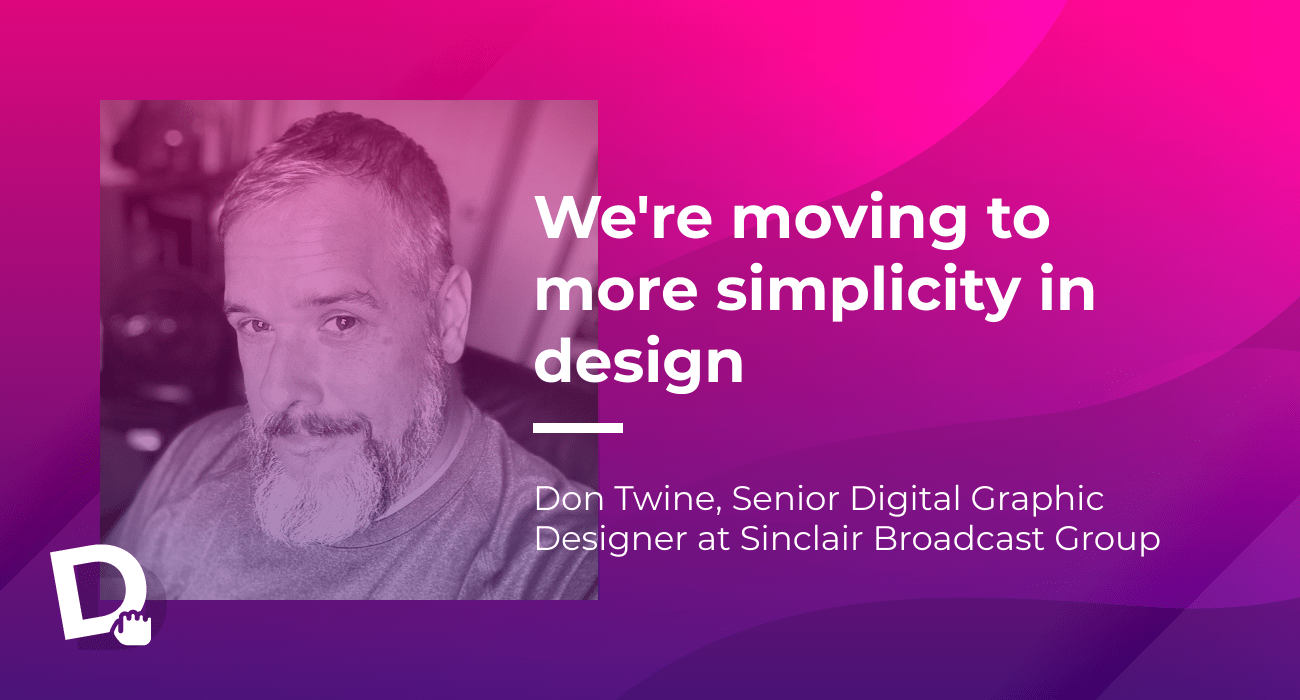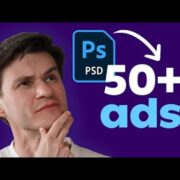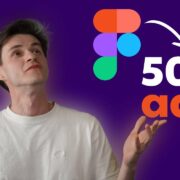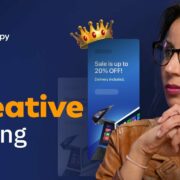Welcome to the Drag & Drop Show!
In today’s episode, John Biggs, our host, breaks down some hot design topics with Don Twine.
Don is a Senior Digital Graphic Designer at Sinclair Broadcast Group, a leading media company and provider of local sports and news. Founded in 1986, the company boasts around 191 television stations, in 89 US markets, producing and delivering content via multiple platforms, including the digital environment.
Don Twine has more than 20 years of experience working in the design industry, so it’s safe to say that he has seen many trends come and go. In this episode, we wanted to pick his brains on design advertising best practices, trends and forecasts.
Whether you are a designer, marketer or a small business owner, below you can find some useful advice:
Key Takeaways
- Advertising is moving to more simplicity.
- Ads with more images and less text have higher click-through rates.
- Always follow the best practices when designing and placing ads.
- When in doubt, use stock images.
- Use eye-catching visuals and work with vibrant colors.
- Work with simplicity and leave room for a little subtlety.
- Stop and examine all the ads around you.
- Having a good Call to Action is essential to an ad’s success.
- Rich media and HTML5 ads are the next big thing.
- Use SVG to make sure that your ads work and display well.
- Your clients don’t understand graphics like you do, so you have to take extra steps to guide them towards the best design decisions.
- Dynamic ads and dynamic content will play a vital role in the future of advertising.
- If you’re just starting out, use social media to get feedback on your designs.
Transcript
John Biggs: So why don’t you tell me a little bit about what you’re working on.
Don Twine: What I do for Sinclair digital is that I design banners for a couple of different areas. We design banners for our individual stations across the country. We also have our own internal digital agency, where we design banners for other clients that are also located across the country. Some of those are tied together with the stations, and some are not.
The type of clientele that I design banners for can range from a small pizza shop to a large bank chain—it really varies a lot. We’ve been using Creatopy since the beginning of 2019, and it’s been great. I’ve been able to really bang out some great designs and put the animation in really quickly. It’s been a game-changer for us.
John Biggs: What do you think folks are looking for, in terms of modern web design? It feels like the banner might be changing or even go away. How do you take that into account?
Don Twine: I think we’re moving to more simplicity, with advertising especially. The one thing that we always like to push is: “Image is more than text.”
We find that the click-through rates are a lot higher when you’re working with more imagery and less copy on an ad.
So we’re always pushing the visuals more and a little bit of animation to get attention on the ads as well because people tend to gloss over everything that has a lot of copy on it. So it’s one thing we’re always kind of steering our sales staff towards when they’re putting in their orders for banners.
John Biggs: You’re always dealing with the traditional. It sounds like you’re dealing with a lot of mom-and-pops. How do you get them to be convinced about the value of online?
Don Twine: Honestly, this is something that our salespeople do more than we do. We try to guide clients towards the best standards for design. We try to follow the best practices when we send ads out. They are general best practices that a lot of companies use as well. This is, just like I said, about using a lot of imagery in your designs, making sure that you have a clear Call to Action on all your ads as well – just things like that.
John Biggs: How do you represent a little business in a small town that needs online representation? How do you represent them best? Is it through images of the place? Is it through images of the food, or images of cool hipsters riding dune buggies? How do you guys think about it?
Don Twine: We try to deal with what the client gives us at first, but then if it’s a small mom and pop shop they really can’t give us a lot of great imagery on their own, so we use a lot of stock imagery. We work with Getty Images, which is great. II try to work with anything that has a lot of colors, something that pops on the ad. We try to work with anything that’s very vibrant, that’s a little more in your face, that really shines in the ads.
I would say work with simplicity, too. You don’t want to have too many things going on in the ad, and as I mentioned before, in the text or pictures.
If I was doing something for a restaurant, for instance, for a small mom and pop, they may send me just a picture of their restaurant outside, and I usually won’t go with that. You go with something that shows the food off really well. So I’ll, I’ll ask them what their menu is, then I’ll check out some stock images and find something that looks very appealing. Something that shows a lot of texture in the food, that really get someone’s attention when they’re going through a webpage, especially a new site where they’re trying to read an article, you want to get them to kind of have their eyes drift off to the side to see something that’s really yummy. So we want to make sure that we use something that catches the eye. Eye-catching – that’s a concept I don’t think will ever go away.
That’s how humans are. Humans are visual creatures, and you want to be able to have something that is going to draw attention.
John Biggs: Do you like the animations that Creatopy has? Do you use that stuff? Or is it mostly just still stuff?
Don Twine: I definitely use animation. I have been doing this kind of work for about 20 years now, so I have a lot of experience working with Flash in the past—that used to take a lot longer to do.
But I try not to go too far with animation. I feel like there’s a fine line sometimes. You want to give attention to the viewer, but sometimes you want a little bit of subtlety too. The nice thing is I can control that in a finite way with the Creatopy animations.
John Biggs: So that’s, that’s actually pretty cool. You’ve seen the rise and fall of all kinds of weird stuff. You’ve seen the “Punch the Monkey” situation. A couple of years ago where you had very specific texts like “New Laws Will Let You Reduce Your Mortgage to 0%” or something like that. And now you’re saying that we’re going back to something a lot more simplistic?
Don Twine: I would say visually a little more simplistic. If you look at, for instance, UI design. I think everything is going to be a little bit more simplistic. If you compare iPhone layouts, the first iPhone came out with all the three-dimensional shiny buttons, and now everything is very flat, bright, and sharp. I think we’re seeing that all across the board, even the web design is developing into something that’s a little simpler.
John Biggs: How do you stay up to date when it comes to that kind of stuff?
Don Twine: I’m constantly online, looking at different ads. Moat.com – I use it a lot and check out what’s there. There’s some good stuff, there’s some not so good stuff on there, but it’s constantly just going to different websites and different areas online to check out what the trends are and how things are being laid out and designed. You can’t just go out and look at things, and it’s hard not to. When you’re in my business, you’re always looking at things anyway, but it’s good to take that extra step sometimes. Even if I’m at home, on my tablet, reading an article, I’m always going to stop and look around to see what kind of ads are on the page. My eye is always going to that—it’s muscle memory for me at this point.
John Biggs: Is there any single thing that you’ve noticed that increases click-through-rates, interaction, or anything? Or is there anything that you’ve gotten down to a science?
Don Twine: Like I was saying, using best practices is always a good thing. I would say that having a good Call to Action is very important. If you don’t have any direction, use a simple couple of words to really get the viewer to click on the ad, it’s very important.
We always tell everyone to steer away from putting a URL on an ad, because the last thing you want is for them to go to that website independently because you can’t track them at that point. We don’t know what are they doing after that. So when they want me to put the URL, I’m always telling them: “No, there really needs to be a Call to Action, and we want them actually to click on the ad, so we can track the success of the ad. That’s very important.”
John Biggs: Have you ever done an ad that just really surprised you in terms of its energy in online?
Don Twine: Some of the ads that we work with use locators. We work with a couple of other ad builders, as well. Rich media is also a big thing that’s up and coming. So banners and videos that have geo-targeting can draw attention.
For instance, I worked on an ad for a lottery. We were able to set up a locator so that everyone could click and find the exact place to buy their lottery tickets from. The ad pointed to a map, and there were like 200 locations. Users could easily go through and find the exact location with one tap, go to Google maps and find out where they could go and where they were distance-wise according to the location.
So I think that rich media content is starting to boom as well.
John Biggs: Interesting! I’ve seen that change over time. Every once in a while, you’ll see: “Here are five great restaurants nearby,” and there’s a little map down in the corner of a Google ad or something.
Don Twine: Rich media is definitely becoming a bigger game player now, especially with the dawn of HTML5, there’s a lot more you can do.
I think that format is really starting to finally mature a little more, once it officially replaced Flash a couple of years ago. It’s now really coming into its own.
John Biggs: What other tools do you have in your toolbox that people should take a look at?
Don Twine: I would say, even with using anything web-based, like Creatopy, I would say that it’s still great to have desktop programs in your toolbelt. Adobe programs are great for that still.
The one thing that I do a lot with Creatopy is that I’m moving into using SVG format a lot more. SVG is a vector format for web, and that’s again, coming into their own, that’s a format that I’ve seen everywhere, especially with logos. Logos that use a vector format tend to look really, really well. They look very good on HTML5 ads, especially when mobile because the displays are now high-resolution. You’re working with iPhones that use Retina displays, so you want all your mobilized to look really crystal clear.
Even desktop displays are becoming a lot more prevalent in having high-resolution devices. So, you want to make sure that you’re designing your ads, so they work well and display well. So the SVG vector format is great for that.
The programs I use – I would say to always have Illustrator in your back pocket. I always ask the clients to provide a vector format, an Illustrator EPS that I can convert to SVG, or if they can’t do that, to at least provide me with something high res’, and I can do a trace in Illustrator, which I’ll do very often. A lot of times, they can’t provide SVG. So as long as they give me something high resolution, I can do a trace that works pretty well. On a small scale, an ad comes out very sharp on mobile devices.
I would say that we can’t get away from our desktop suites yet. They’re still a good resource to have, even when you’re working with online builds.
John Biggs: So looking into “Why SVG?” is making sure that resolution is good throughout, right?
Don Twine: Correct, working with anything that’s high resolution or anything that’s rasterized, you want to make sure that it’s a double resolution to make sure it’s going to show well on small devices or mobile devices. I’ve been moving towards using a lot more SVG vector graphics. It hearkens back to Flash because it was very vector-based. Now, having a format like SVG works well in HTML5, I feel like it’s a full circle, a little bit going back to the one thing that I really liked about Flash.
John Biggs: You think that “Punch the Monkey” is coming back? I think that’s got some legs still.
Don Twine: Sure. Everything eventually comes back around. I’m sure we’ll see bell-bottoms roll out again or something.
John Biggs: Have you ever had a client that wouldn’t listen and just gave you some absolute junk, and you just had to run with it?
Don Twine: Yes. I think that’s the plight of any designer—having to deal with clients that are like that. The best thing you can do is try to guide them. I’ll try to give them at least a choice to say, “Well, I can do this, but I can also do this.”, so they at least they can see what could be, and very often that works. If I’m able to show them a side by side comparison to what they want, and what I can do for them, very often they’ll bend and say, “Okay, that works better.”
I think a lot of people don’t understand graphics a lot, they’re not visual people like us designers are, so they need a little more help.
They need to be able to see what we’re talking about. They can’t just take it for granted for what we say. We, designers, have to take that extra step to let them see things for themselves and make that decision.
John Biggs: What does the future look like for your job?
Don Twine: Rich media’s a big thing right now. I mean: more video ads, more components like interactivity, locators in ads for geo-targeting and dynamic ads, and dynamic content.
For instance, if you were a company that wanted to sell different things depending on what kind of weather is going on outside, there’d be ads that would dynamically change, based on what’s going on. So, if it’s raining, it would show rain boots. If it were snowy, it would show an ad for a scraper for your car or something like that.
Dynamic ads are becoming a big thing in our industry, and a couple of things with the weather, time, audience-based, and deep based as well. We do a lot of ads with that.
I think that dynamically generated content is becoming a big thing now.
John Biggs: Interesting! Do you see a move towards that, or is that going to take a while?
Don Twine: It’s starting to become a little more prevalent. I think we’re going to see that grow over time. I think it’s a saturation type of thing. Clients need to know that that’s an option out there, and I think it’s just starting to get out there.
John Biggs: What’s your best advice for someone just breaking into this industry?
Don Twine: Do your research and see what’s going on out there, even in your spare time, when you’re online looking at things or reading articles. If you’re looking to design ads, keep an eye on everything that you’re looking at while you’re out there. Take a minute to look at the ads that are popping up. I would say even in the real world, check out billboards, check out things that you see outside. They’ll give you an idea of what’s going on and of how or where design is going.
And practice, practice, practice! Find a tool and create ads. Even if you can’t find a job and you can’t find an internship, don’t let that stop you. Try a couple of different tools out online to make some ads. If you can’t afford Photoshop, there are other tools out there that do pretty well that allow you to put different ads together, and it’s always great to just put things online. With the dawn of social media now, you can get your designs out there to different places to get input.
I’ve seen a lot of different designers that use Instagram as a tool. They design some things and put them out there, hashtag them, and they get feedback sometimes.
So, I would say use social media to your advantage if you’re trying to get some feedback on your work.
John Biggs: Should people hit you up on your Instagram, or did you shut yours down?
Don Twine: Mine’s available on there, I don’t have a professional one, but now that you’re talking, I actually think that I might want to do that.
John Biggs: Yeah, it might be fun, right? You can share your thoughts with the world. It seems like really helpful pieces of advice, though.
Don Twine: Yeah!
John Biggs: Don, thank you for joining us. This is going to be really interesting, and I think folks are going to like it a lot, as they are going to be helped by this.
Don Twine: Great, glad to help!
We agree that simplicity is making a comeback in the online design industry, and we also believe that the right tool can help you create some amazing ads and visuals. From catchy stock images and irresistible Call to Action ideas to HTML5 ads, our web design tool has got you covered.
Click here to give Creatopy a spin.
If you liked this episode, hit “Subscribe” to get notified of the latest episodes wherever you get your podcasts:
Thanks for tuning in!
The Drag & Drop Show is an original series created by Creatopy.












